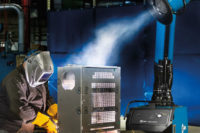Air quality has an impact beyond employee health and well-being – particulate can create hazardous conditions and increase the risk of property damage from fires and dust build-up on equipment. One manufacturing company implemented a new fume collection system to not only improve working conditions for its employees but to increase the overall efficiency and safety of their plant.
Background
Wenthe-Davidson is a metal fabricator that specializes in manufacturing electric motor frames and custom products. The company prides itself on efficient manufacturing processes that generate high-quality products in exact quantities to support its customers “Just-in-Time.”
This focus on customer satisfaction has led to significant growth for Wenthe-Davidson, which in turn has required the addition of new manufacturing equipment to their facility. More equipment means more smoke and weld fume, and air quality began to diminish in the plant.
Their existing exhaust system used fans that were ducted to individual robot and seam welders, and these fans were unable to generate enough exhaust air and dust velocity to effectively remove particulate from the air. Dust that settled in the ducts resulted in multiple minor fires within the ductwork. This highlighted the potential risk of future, larger fires which increased the risk of danger to employees and damage to the manufacturing facility.
The previous ducted system required manual cleaning of ductwork, motors, and blowers due to its lack of effective filtration. In addition, the system exhausted the collected air outside the facility, requiring “make-up” air to eliminate potential negative air pressure in the building. This drove up operating costs, especially during the winter when already heated exhaust air was lost and new make-up air had to be heated.
Weighing the options
Wenthe-Davidson sought a new solution that would reduce the amount of harmful particulate their employees were exposed to and minimize the risk of fire, while conserving energy in the process. Initially, Wenthe-Davidson considered a ducted fume collection system, but discovered that the cost and space requirements of this type of system were very high, especially the ongoing operating and maintenance costs. They then evaluated an ambient air filtration system utilizing a unique filtration unit with energy optimizing controls that would create the necessary air exchange rates to effectively remove particulate from the air and promised significant energy reduction and cost savings compared to other options.
The ambient collection units would also be able to be monitored remotely through Wenthe-Davidson’s network, allowing maintenance personnel to track filter status, monitor system faults, and turn the system off from anywhere in the world. Administrators could schedule unit operation based on production schedules, so units can automatically turn on and off as required to conserve energy.
The benefits of ambient collection
Wenthe-Davidson’s ambient collection system requires very little maintenance, as the selected ambient units have filters that can be cleaned to extend their life and reduce costs in the long term. Administrators can monitor filter pressure and other metrics directly on the units themselves or remotely from the monitoring tool. They are able to cycle through filter cleaning on an as-needed basis and the units can continue operating during the process, whereas the previous system required the entire system to be shut down for cleaning and maintenance.
The non-ducted ambient collection system also has a smaller footprint that opened up additional work space in Wenthe-Davidson’s facility. By removing the ductwork in the facility, they are able to move manufacturing equipment to new locations as needed to streamline production without having to consider the air cleaning equipment – the new system cleans all of the air in the building, not just in specific areas where welding is taking place. The external exhaust blowers and ductwork have been eliminated and the new system runs on filter pressure, which reduces the amount of energy required to operate the system.
Results
Post-installation testing revealed an 82-percent reduction in weld fume, and Wenthe-Davidson’s employees immediately noticed an improvement in air quality in the manufacturing plant once the ambient collection system was in place. The new system significantly reduced the risk of fires which increased employee confidence, and Wenthe-Davidson was able to create a cleaner and more comfortable work environment as the amount of dust and smoke in the air decreased.
Said Peter Bruce, maintenance manager, “I like this system for the adaptability to our ever changing production floor and the online monitoring and trending for easier maintenance planning, and our employees are happier with cleaner air."


